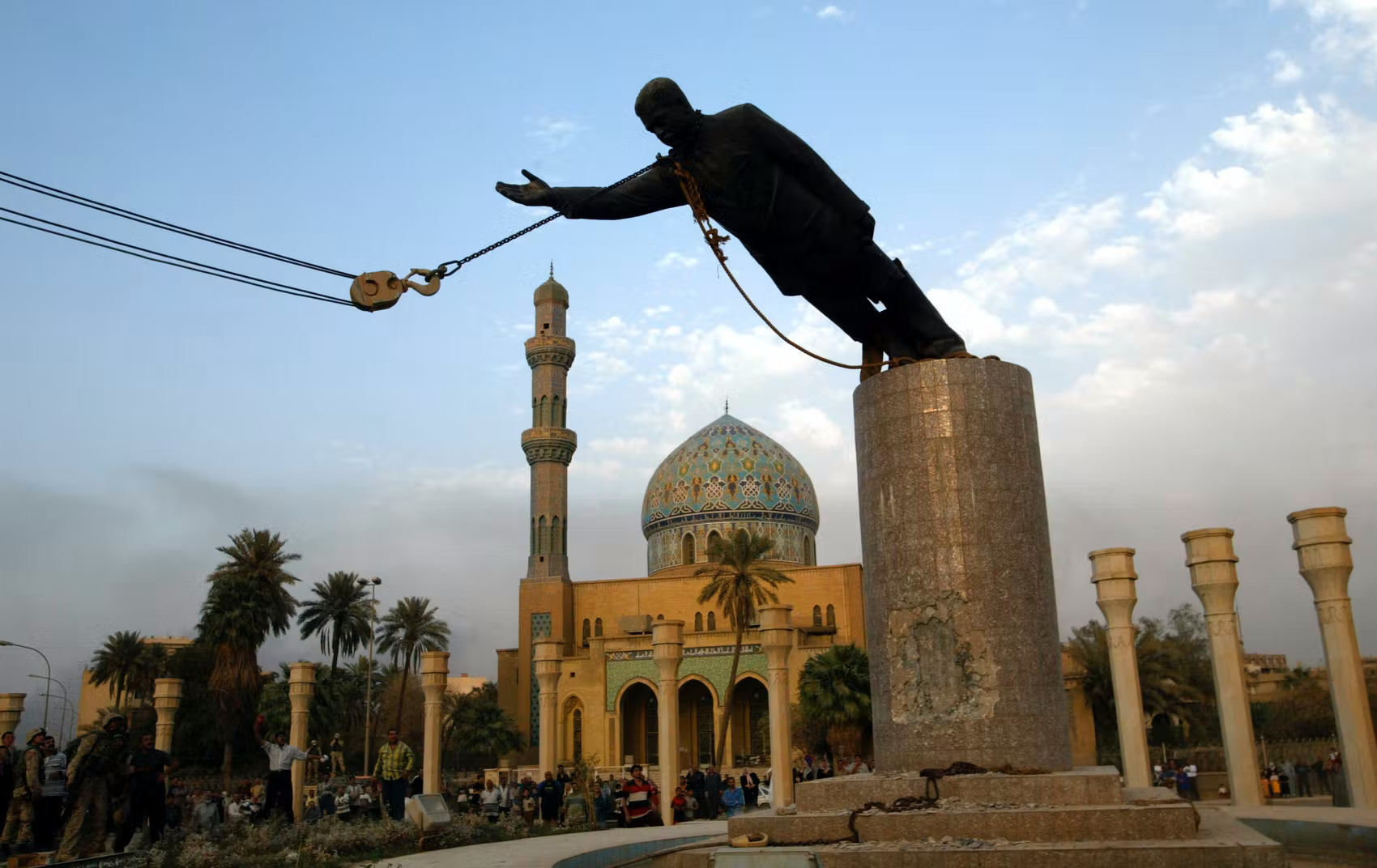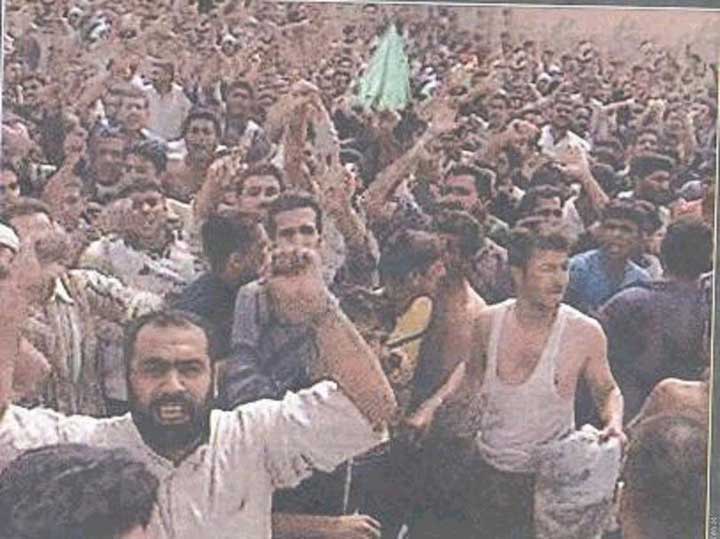
Firdos Square Incident

The iconic, and staged, image of the statue falling
As the mainstream media reported it, on April 9th a crowd of angry Iraqi civilians stormed the Firdos Square and destroyed the statue of Saddam Hussein that was erected there, passing off photos and videos of the destruction as proof that the US led intervention
had worked and that the reign of Saddam was now unpopular to the average Iraqi... But sooner rather than later holes began to appear in the story regarding the statue's destruction that were pointed out for all to see.
One piece of evidence that actively works against the claim that it was solely Iraqi civilians that called for the destruction of the statue was that the US military showed up mere minutes after the first protesters with sledgehammers did, combine this with
the fact that the statue itself was pulled down not by Iraqi civilians and instead an M88 armored recovery vehicle it's clear that something here is fishy.
One prime example of media manipulation in this event comes from the English newspaper 'Evening Standard', a tabloid news company that was caught red handed digitally altering a photo of what they claimed to be Iraqi civilians in Baghad celebrating the toppling of
the statue in Firdos Square.

The cover of the issue with the altered image

The raw image, ready for public scrutiny
Let's pick this image apart piece by piece, because trust me. It's a complete mystery how anyone even approved this image with how blatant the fakery at play here is, it's honestly embarassing.

This perhaps is the most glaring and damning detail, I mean just look at it, human arms are not that long and they most certainly do not get that thin around the wrist. How did someone look at this and say it looks perfectly fine?

This one is less subtle but easy to notice once you point it out, the man in the white shirt is what really shows that this image was stitched together using numerous images; these aren't different people they are the same man. Even with how blurry the image is you can tell that the facial hair on both men are the same, the same logic fits with the man on the left. They're both the same guy copy and pasted again to give the illusion of the crowd being bigger.

Here I've highlighted what I'd say that this appears to be a man in a turban who was copy and pasted around the image a few different times, pretty basic photo doctoring techniques and easy to spot with a trained eye, those are the most glaring signs of fakery
but if you want a more indepth explanation take a look at this image analysis done by an IndyMedia user back in 2003.
But now that we've established they faked the photos, let's get back to how they faked the destruction of the statue itself.
It's clear now all these years later that the destruction of the statue and painting it as an Iraqi action was nothing more than PR for the war effort back home, at the the time the Iraq war was incredibly unpopular because the
Bush administration tacked on the war to the invasion of Afghanistan at the last second in the wake of the 9/11 attacks, trying to flimsly connect Saddam Hussein to the 9/11 attacks as a justification but ultimately failing so most felt as if the war was completely
and totally unjust and a violation of international law as Iraq had not taken any direct action against the US that would justify a full scale invasion.
Simply put this toppling was staged by the US Marines simply to make it look like the military action was not a hostile occupation but instead a peaceful intervention and that the Iraqis were thankful for the help of the US Government in liberating their country,
this was a media backed psyop targeted directly at trying to undermine the anti-war movement and all criticism of the Iraq war, later retrospective analysis of the incident revealed the following details were obscured in the
initial media reports of the incident
- Media Vastly Exaggerated Attendance: Though we're all familiar with the photos of a crowded-seeming square, ProPublica reproduces photos showing that the square was actually mostly empty, but that media portrayals used tight-focus shots of a small cluster of people to suggest it was packed. Maass adds, "very few Iraqis were there. If you were at the square, or if you watch the footage, you can see, on the rare occasions long shots were used, that the square was mostly empty. You can also see, from photographs as well as video, that much of the crowd was made up of journalists and marines." Of even the small number of Iraqis there, Maass says most were subdued, standing with their arms crossed. "Closeups filled the screen with the frenzied core of the small crowd and created an illusion of wall-to-wall enthusiasm throughout Baghdad. It was an illusion that reflected only the media’s yearning for exciting visuals." But that just isn't accurate.
- U.S. Provided the Sledgehammer and Iraqi Flag: A thirty-five-year-old gunnery sergeant named Leon Lambert, who commanded an M-88 military tow truck, gave the Iraqis the iconic sledgehammer used to knock down the statue. "If a sledgehammer and rope fell off the 88, would you mind?" Lambert asked his superior. As for the flag, it's "One of the Firdos myths" that Iraqis brought an Iraqi flag to put over the statue. Another myth is that it was brought by a U.S. "psyops team." In fact it belonged to Marine lieutenant Casey Kuhlman, who happened to be in the area and had decided that an Iraqi flag should replace the U.S. flag that had briefly covered the face on Saddam's statue.
- Media Ignored More Important News for 'Upbeat' Story: Maass says that, in the rush to cover the state-toppling, the media ignored or avoided far grimmer--and more important--stories: "On that day, Baghdad was violent and chaotic. The city was already being looted by swarms of people using trucks, taxis, horses, and wheelbarrows to cart away whatever they could from government buildings and banks, museums, and even hospitals. There continued to be armed opposition to the American advance." But, "The networks almost never broke away from Firdos Square"
However the most damning and indepth explanation on how the Firdos Square incident was faked comes from ProPublica, although the report is long I highly recommend reading it, or alternatively you could watch this three minute video also produced by ProPublica that covers the information presented in the article.
The Toppling: How The Media Created The Iconic Fall Of Saddam's Statue
Return to Homepage